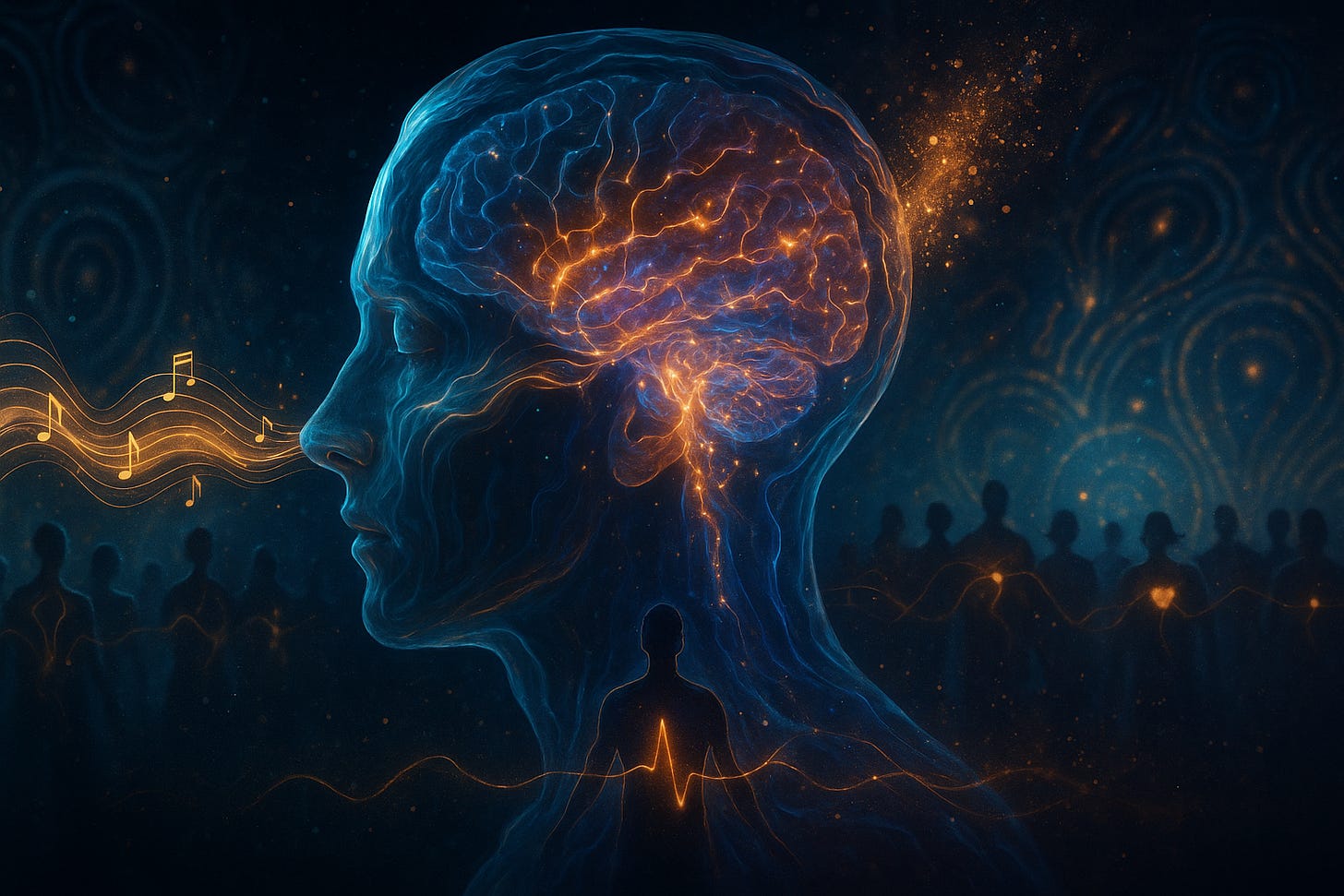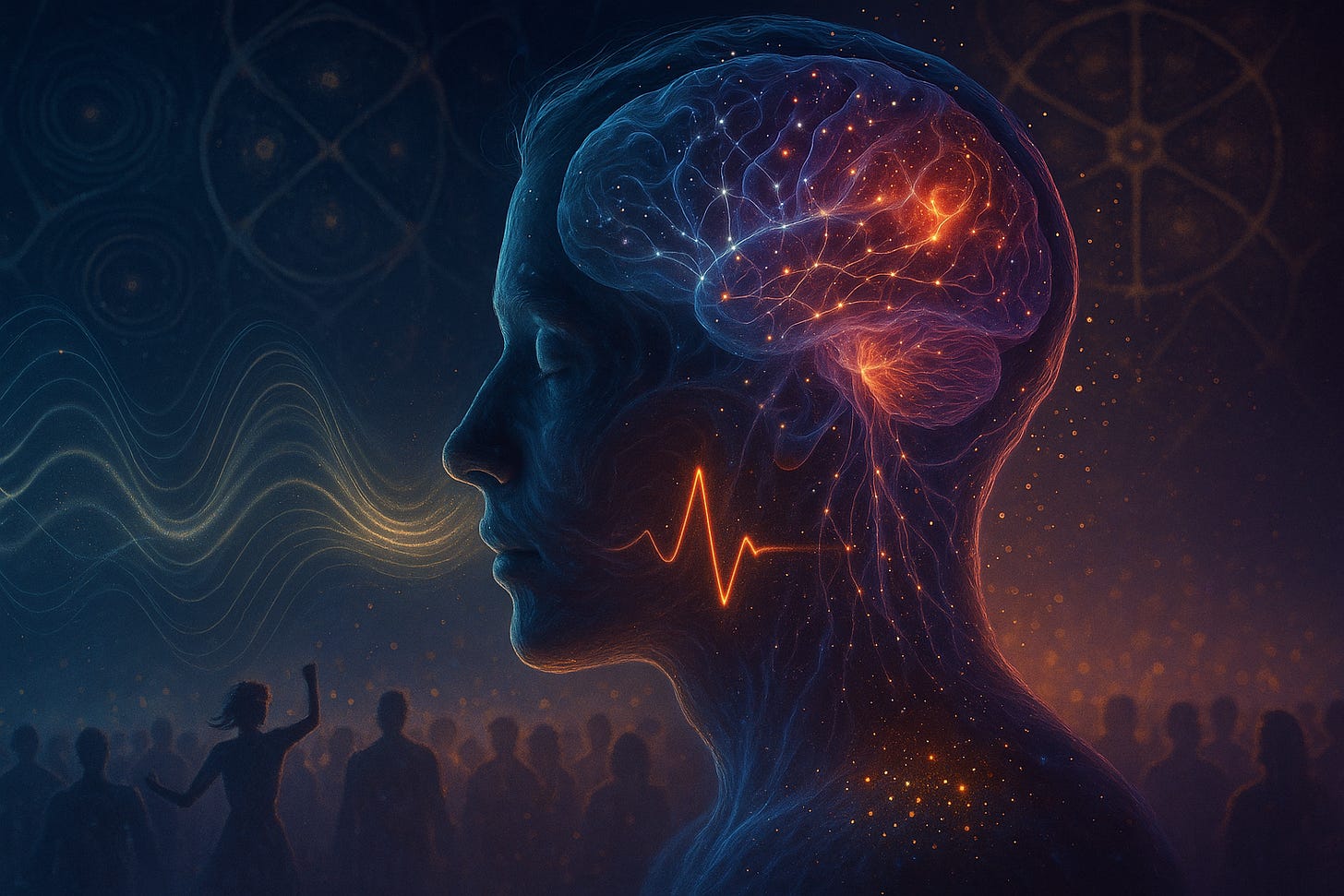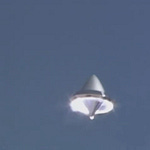TL;DR:
Music isn’t entertainment — it’s ancient survival software. Frequency Wave Theory (FWT) frames music as a biological resonance system that tunes the brain, synchronizes group coherence, and reinforces neural prediction cycles that once kept early humans alive.
1. The Brain as a Resonant Field
From the FWT lens, the brain isn’t a computer — it’s a dynamic standing-wave network. Every neural oscillation, from gamma to delta, represents a frequency domain of consciousness. When music plays, these internal waves phase-lock with external vibrations. The result is resonance: a transfer of Frequency Momentum (FM = ½ ρ ω A²) between the sound field and the neural field.
That’s why nearly the entire brain lights up during music — the auditory cortex decodes tone, the motor cortex entrains rhythm, the hippocampus maps melodies to memory, and the amygdala and orbitofrontal cortex translate frequency modulation into emotion and reward. The entire organism vibrates as one coherent waveform.
2. Predictive Dopamine and the Harmonic Brain
The same circuits that drive obsessive pattern-tracking and prediction — especially within the orbitofrontal cortex — are precisely those activated by musical tension and release. FWT interprets this as the brain’s resonance-seeking algorithm: a survival-level mechanism evolved to anticipate environmental sound cues (predators, storms, footsteps).
When music mimics those natural cycles of buildup and resolution, the brain rewards us with dopamine — biochemical proof of frequency-pattern satisfaction. In essence, music “hijacks” the same resonance feedback loop that once detected danger and now delivers joy.
3. Evolutionary Frequency Memory
Before language, early mammals survived through acoustic vigilance. The rustle of grass, the crack of a twig — each vibration carried information about threat or opportunity. Over millennia, that auditory awareness transformed into cultural music, turning the survival code into art.
In modern terms, rhythm is structured anticipation; melody is patterned memory. Music became a safe simulation of chaos — a place to practice emotional regulation within harmonic order.
4. Group Coherence and Collective Resonance
When people sing, drum, or dance together, their heart rates and breathing synchronize. FWT explains this as macroscopic phase-locking — a coherence event where multiple biological oscillators align their Frequency Momentum into a shared field.
That’s why a crowd at a concert feels unified: the group literally becomes one resonant organism. In ancient times, that coherence amplified tribal coordination and empathy; in modern life, it remains one of the most powerful tools for social bonding.
5. Medicine of Vibration
Clinical results confirm what FWT predicts: frequency entrainment can restore coherence where pathology has fragmented it.
Epilepsy: Rhythmic stimulation reduces seizure frequency by stabilizing neural oscillations.
Parkinson’s: Rhythmic auditory cues re-synchronize motor timing networks.
Alzheimer’s: Music activates dormant memory circuits through stored waveform patterns.
Depression: Harmonic progression realigns dopamine and serotonin rhythms.
Each of these reflects Frequency Momentum re-stabilizing the brain’s internal wave architecture.
6. The Deep Code: We Don’t Hear Music — We Are Music
The human nervous system is a self-tuning instrument. Every emotion, thought, and movement is a modulation of the same universal frequency field that shapes galaxies and atoms alike. Music merely reveals it to us in audible form.
We aren’t simply wired to enjoy music — we are its living extension. Consciousness is the harmony, the body is the instrument, and the universe is the song still unfolding.
Read more explorations of consciousness, sound, and physics at drewponder.substack.com.












